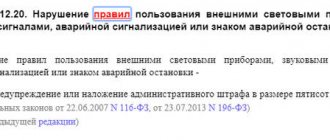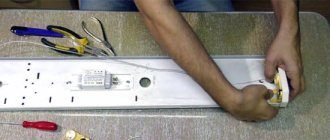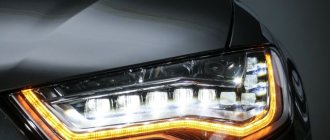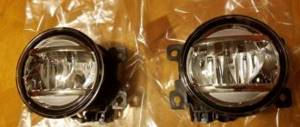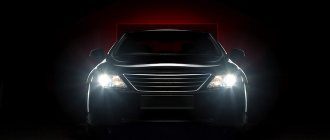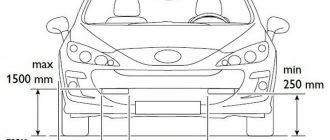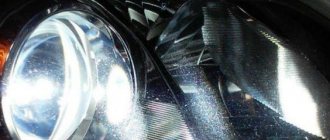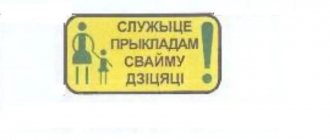Fog lights and lights
This type of light source is part of the overall vehicle lighting system. Lighting equipment is designed for more intense illumination of the road at night, as well as in bad weather, when the visible distance is insufficient for safe movement. This system includes:
- Headlights, taillights and brake lights.
- Car showroom lighting, glove compartment lighting, luggage compartment lighting.
- Front fog lights and rear fog lights.
- Illumination of registration plates and information control panel instruments.
Xenon
There are many different fables about xenon, for example, that it is banned in Russia. Not at all - if the car is equipped as needed (read, has xenon from the factory), then the owner will not have any problems. It’s a different matter if xenon appeared in the car at the will of the owner. Determining the legality of xenon is quite simple - if the headlight has a marking that begins with the letter “D”, it is a headlight for xenon; if the first letter is “H”, then it is for halogen. And this is not a stupid requirement - the light dispersion of different types of lamps is different, and the headlamp must initially be designed specifically for this type of light. Typically, lensed optics are used for xenon (this does not automatically mean that if there is a lens, xenon can be installed), but there are examples of the implementation of factory xenon in a reflector headlight.
Is it possible to install xenon yourself? If your car has factory kits, then no problem. I bought standard headlights and washer and installed them. And if not, then there is nothing to talk about. It is impossible to legally install xenon, for example, on a “nine” - certified xenon headlights for this car are not produced. But installing them as standard ones, even with a washer, is still illegal. By the way, all xenon headlights must have a washer, because this light greatly changes the scattering properties of dirty headlights.
This car will blind oncoming people
The same rules apply to installing xenon in other types of headlights, for example, fog lights. If there are no factory certified options, then such a procedure will not be legal.
Another fable is that xenon in conventional headlights can be adjusted so that it does not glare. Of course, you can lower the light beam lower, but then the driver will not see the road as needed. Illumination standards for low and high beams were not invented out of the blue, but with specific visibility requirements. A lowered xenon light beam will shine brightly, but not far enough, and if raised, it will inevitably blind oncoming people.
Types of foglights
According to traffic regulations, the use of fog lights is officially permitted; many manufacturers equip factory-produced cars with fog lights. But many universal types are also produced by third-party companies. By type there are:
- Front fog lights;
- Rear fog lights.
The design features differ in the source of light used. Common types of fog lights:
- Halogen. Relatively inexpensive light sources, in demand among car enthusiasts. The disadvantages include the short service life of the lamps. During intensive use, they require frequent replacement;
- Xenon. The characteristics of the light spectrum are better than those of halogen lamps. They work long enough. The price is quite high;
- LED fog lights. The highest price category. Lamps with excellent light beam. They have a long service life. Lamps are prone to overheating. Requires fairly good ventilation.
How to determine the visibility limit?
The use of fog lights is strictly regulated by traffic regulations. Poor visibility of the roadway is when the visibility to the car in front is less than 300 meters at dusk, as well as in a situation where it is raining, foggy or snowing heavily. How can you tell by eye in bad weather that visibility is limited? It is necessary to count the power line supports that are installed along the road. If less than 6 pieces are visible, then the view is difficult and is less than 300 meters. The distance between the pillars is fifty meters. In such conditions, it is necessary to reduce the speed of the vehicle and be extremely careful.
When are fog lights used?
According to standard No. 19.4 of the Traffic Regulations, front fog lights are designed for additional illumination of the roadway at night or when dusk falls, together with headlight devices. Use is permitted in unlit areas or in conditions of limited visibility caused by weather conditions. And also as running lights, instead of low beam, according to paragraph No. 19.5, during the day. A detailed explanation of traffic rules and GOST can be read in this article: https://businessman.ru/new-dnevnoj-xodovoj-ogon-razyasnenie-gost-i-pdd.html. Separate regulations apply to the operation of rear lights. When according to traffic regulations do you turn on the fog lights installed at the rear of the car? Rear fog lights are intended only for additional identification of the vehicle in conditions of poor visibility: fog, snowfall, heavy rain, etc. Turning on in normal situations is prohibited.
How much can they be fined?
Finally, the rules for using external lighting devices are also important.
There are several of them, and they are simple. Even during the day, you must drive with low beam headlights or daytime running lights on. By the way, it is not forbidden to use fog lights as such. But rear fog lights are allowed to be used only in conditions of poor visibility, since in other cases they have a blinding effect for drivers behind. You should not use lighting equipment for other purposes, even if you absolutely need to express your emotions. Ethics are ethics, but, strictly speaking, even an emergency signal as a “thank you” is a violation of traffic rules. The same applies to blinking your high beams: traffic regulations allow you to do this only to warn about overtaking and to warn the oncoming driver that he is blinding you. If you blink to warn of a traffic police ambush or chase someone out of your way, be prepared for a 500-ruble fine.
Did you like the article? Give it a like!
Source
Installation
It is worth paying attention to the correct installation of additional lighting sources. Installation of fog lights according to traffic regulations in Russia has some features and limitations:
- The emitted light should be in the milky white spectrum or have a bright yellow color.
- Installation of only paired directional light sources is permitted. The type of lamp used must be of the same type.
- Installation of an additional device is possible no higher than the level of stationary car headlights. The lowest point should be higher than 25 centimeters from the surface of the roadway.
- According to the dimensions of the vehicle, the separation cannot exceed 40 cm (for a vehicle width of 1.3 m) and 60 cm (for others).
- The connection of the fog lights must be connected to a separate toggle switch.
- The angle of the emitted light beam should be between -10 and +15 degrees vertical.
- The horizontal angle should be between -10 and +45 degrees.
The rules do not regulate the exact installation location.
Is it possible to install additional headlights according to traffic regulations?
No you can not. This, unfortunately or fortunately, as of 2021 is prohibited by two regulations at once:
Thus, placing additional headlights, no matter what light source they have - native halogen or xenon or LED - is prohibited.
Is it possible to make changes to the design officially?
But a number of tuning and other improvements, as we know, can be officially registered with the traffic police. For example, you can legalize gas equipment or install an additional towbar on your car. Is it possible to similarly install additional headlights as lighting sources and make changes to the traffic police? No!
The fact is that such changes are simply not permissible, because the regulations directly prohibit the installation of additional main lighting sources. And this applies to both low-beam headlights and fog lights.
But there is such a term in the Technical Regulations as “optional lighting source”. They also have their own requirements, and, alas, this legal act does not provide for any additional headlights on passenger cars.
Additional headlights can only be installed on vehicles of category N3, and these only include trucks weighing over 12 tons. And passenger cars belong to category M (M1).
Thus, even if you plan to register a design change by installing optional headlights in addition to the factory ones, then, in addition to the expensive formal process of such changes, including undergoing additional examinations and safety tests, you will ultimately be denied registration.
But here we are talking specifically about structurally standard headlights, which are most often placed on the bumper or in the radiator grill of a car. And there is another separate term in the regulations - “spotlight”.
Roof spotlight
It is permissible to install such a device on a car only if it is provided for by the design. This is directly evidenced by the same requirements for optional light sources.
Fog lights, if there were none
Another question is if your car was originally produced without fog lights, but you decided to install them additionally. The situation here is twofold:
Rear fog lights
It is prohibited to connect rear fog lights together with brake lights. It is also not allowed to turn on the rear fog lights if the overall visibility is equal to or higher than 300 meters. Such restrictions have objective reasons. The brightness of the rear fog light sources is the maximum of all the lights present in the rear of the vehicle. They are even brighter than brake lights. With sufficient visibility in normal weather conditions, they cause blinding of drivers behind the cars. It is also strictly unacceptable to combine the buttons for turning on and off the front and rear fog lights.
Additional LED lights
What do the regulations say about installing LED fog lights?
To answer this question, let's start with the main headlights. Is it possible to change the headlight bulbs recommended by the manufacturer to xenon or LEDs? Traffic regulations give a precise answer: if the manufacturer recommends or could install non-halogen light diffusers on the conveyor for a specific car model, then “upgrading” is permissible. To put it simply, everything that is included in the vehicle configuration is permissible, everything that is not provided is prohibited. If you simply replace halogen lamps with LED fog lamps, then due to the design features of the headlight (the diffuser lens only works correctly with the lamp intended for it), there will be almost no good effect. The headlights will, of course, emit more light, but the beam formation will be incorrect. It will not be possible to achieve the desired result without replacing the headlights themselves, except for blinding oncoming drivers.
All the same rules apply to fog lights with LEDs. The installation of fog lights not provided by the manufacturer according to the traffic rules (Article No. 12, paragraph No. 5) provides for punishment. It is illegal to operate a vehicle with lights that are not designed for a specific model. Will lead to deprivation of a driver's license for a period of 6 to 12 months with confiscation of light sources.
Photos provided by the Internet agency "DreamTrade"
What's the fine?
All measures of liability for violations of the list of conditions under which it is prohibited to drive a car in 2021 are regulated by Article 12.5 of the Code of Administrative Offenses. And its first part establishes a fine for the absence of PTF as one of the following conditions:
1. Driving a vehicle in the presence of malfunctions or conditions under which, in accordance with the Basic Provisions for Admission, the operation of the vehicle is prohibited, entails a warning or the imposition of an administrative fine in the amount of five hundred rubles.
Thus, you cannot drive without fog lights, and the fine for this is 500 rubles. In rare cases, you can get away with a warning. But the latter is carried out, indeed, in very rare cases. Even when appealing a fine, judges and traffic police chiefs, according to judicial practice, almost never replace a financial sanction with a warning.
This fine for the absence of fog lights can be paid with a 50% discount within the first 20 days from the date of the decision, and no other enforcement measures (evacuation, prohibition of operation) are provided.
But in 2021 there is a more terrible responsibility for the lack of PTF, we’ll talk about it!
Cancellation of registration
Paragraph 3 of Order No. 399 on the procedure for vehicle registration prescribes that traffic police inspectors are prohibited from registering vehicles in cases where changes are made to their design without the permission of the State Traffic Inspectorate.
At the same time, paragraph 50 speaks of the possibility of termination of registration if there are grounds specified in paragraph 3.
Removing fog lights for any reason - be it an unauthorized act or the result of an accident - is, in essence, making changes to the design. Therefore, by law, employees are required (not just have the right, but are required) to cancel the car’s registration.
This practice developed not so long ago and has been in effect for the last few years. But, basically, a car’s registration is canceled for tinting and real design changes (replacing the engine with a more powerful one, non-original body parts, etc.). But for the lack of fog lights, there is no such practice in 2021. It exists only in legal norms, but nothing prevents any traffic police inspector from making it a reality.
